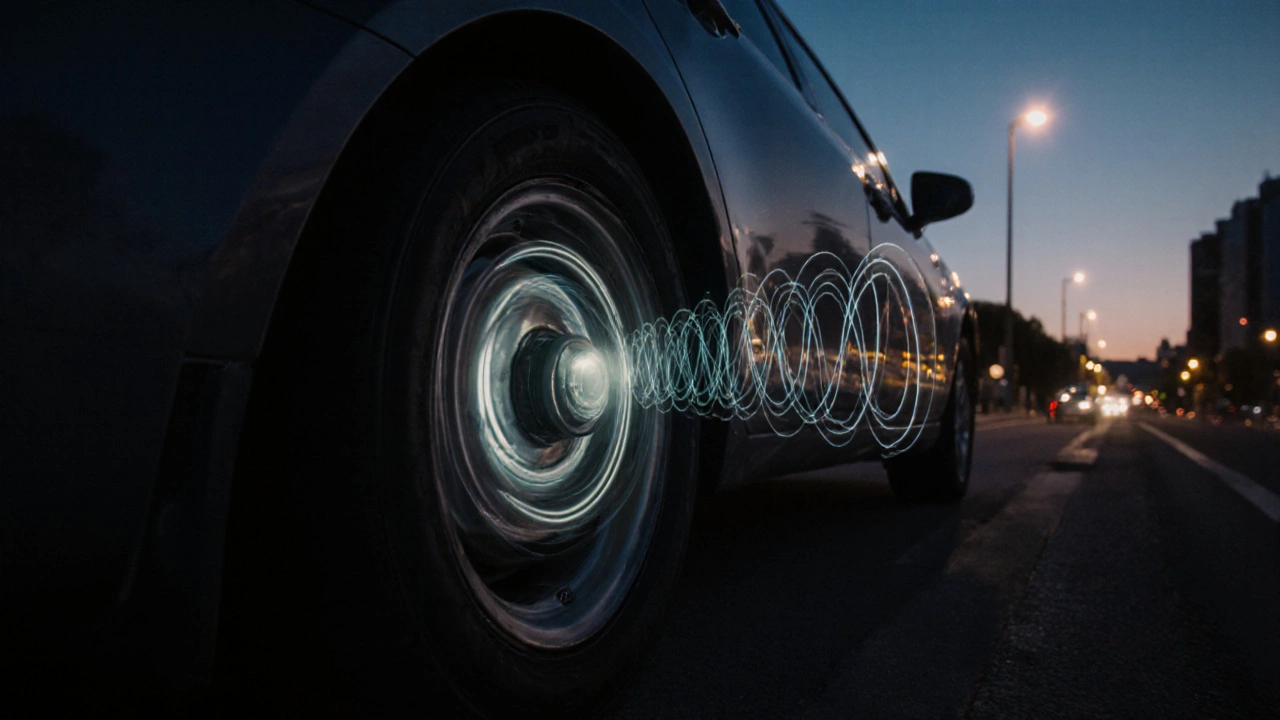Brake Pad Thickness Checker
Check Your Brake Pads
Measure your brake pad thickness to see if replacement is needed. Minimum safe thickness is 3mm.
Your car makes a squealing sound when you stop. Or maybe the pedal feels spongy, or the car pulls to one side. These aren’t just annoyances-they’re warning signs your brake pads might be worn out. Ignoring them isn’t just risky; it’s dangerous. Brake pads are one of the most critical safety components in your car, and they wear down over time. Knowing how to check them yourself can save you money, prevent accidents, and keep you in control when you need it most.
What Brake Pads Do and Why They Wear Out
Brake pads are the friction material that clamps down on the brake rotors when you press the pedal. That friction slows your car. Every time you brake, a tiny bit of the pad material rubs off. It’s normal. But over 20,000 to 70,000 miles-depending on your driving style, car weight, and road conditions-the pads thin out until they no longer work effectively.
City driving with lots of stop-and-go traffic wears pads faster than highway cruising. Heavy vehicles like SUVs or cars loaded with gear put more stress on the brakes. And cheap brake pads? They don’t last as long as quality ones. You can’t avoid wear entirely, but you can spot it early.
Visual Inspection: The Easiest Way to Check
The most reliable way to check brake pad wear is to look at them. You don’t need to remove the wheels on most modern cars. Just peek through the spokes of the wheel.
- Find the brake caliper-it’s the metal clamp holding the rotor.
- Look through the gaps between the wheel spokes. You should see the brake pad pressed against the rotor.
- Measure the thickness of the pad material. If it’s less than 3mm thick, it’s time to replace them. Some experts say 4mm is the cutoff, but anything under 3mm is a hard no.
- If you can’t see the pad clearly, use a phone flashlight. A quick glance can tell you more than you think.
Don’t just check one wheel. Do all four. Front pads wear faster than rear ones-often twice as fast-because most of the braking force is on the front axle. If your front pads are at 2mm and the rears are at 6mm, you’ve got a clear picture of where the problem is.
Listen for the Warning Sounds
Most brake pads have a small metal tab called a wear indicator. When the pad gets too thin, this tab scrapes against the rotor. It’s not a loud squeal like a bird-it’s a high-pitched, consistent whine that happens every time you brake, even gently.
Some drivers ignore it, thinking it’s just "the car being noisy." But that sound is there for a reason. It’s designed to be annoying enough that you can’t ignore it. If you hear it, don’t wait for the next service. Get the pads checked within a week.
Not all cars have wear indicators. If yours doesn’t, you might hear a grinding noise instead. That’s metal-on-metal. Your pads are gone. The caliper is now scraping the rotor. That’s expensive damage-rotors cost £100-£200 each to replace. Pads? £30-£80 per pair.

Feel the Difference in Braking
Your brakes should feel firm and responsive. If you notice any of these changes, it’s not your imagination:
- The pedal sinks closer to the floor before the car slows down.
- You need to press harder to stop the same way you used to.
- The car takes longer to stop, especially at higher speeds.
- You feel vibration or pulsing in the pedal when braking.
These aren’t just "feelings." They’re symptoms. Thin pads mean less friction. Less friction means more distance to stop. A car going 60mph needs 120 feet to stop on dry roads with good pads. With worn pads? That jumps to 150 feet or more. That’s the length of a tennis court.
Vibration or pulsing usually means the rotor is warped from overheating-often caused by dragging pads or metal-on-metal contact. That’s a secondary issue, but it’s serious. You’ll need a new rotor, not just new pads.
Dashboard Warning Lights
Not all cars have brake pad sensors, but many newer models do. If your brake warning light comes on-usually a yellow or red circle with an exclamation mark inside-it’s not about low fluid. It’s often telling you the pads are worn.
Check your owner’s manual. The symbol might be different depending on the brand. Some cars show a "BRK PAD" message. Others just flash the general brake light. Either way, if it’s on and you haven’t just topped up brake fluid, get the pads checked.
When to Replace Them
There’s no one-size-fits-all timeline. Some drivers replace pads every 30,000 miles. Others get 60,000+ miles. It depends on:
- Driving habits (aggressive braking = faster wear)
- Vehicle weight (heavier cars = more stress)
- Brake pad quality (OEM or premium brands last longer)
- Climate (wet, salty roads accelerate corrosion)
As a rule of thumb: if you haven’t checked your pads in over 12 months, it’s time. Don’t wait for the sound or the warning light. Make it part of your annual check, like an oil change.

What Happens If You Don’t Replace Them
Driving with worn brake pads isn’t just risky-it’s illegal in the UK if your brakes don’t meet minimum safety standards. Police can fail your MOT for pads under 1.5mm, and even 2mm might get flagged if the inspector thinks they’re close to failure.
But beyond fines and MOT failure, the real cost is safety. Worn pads mean longer stopping distances. In wet conditions, that gap becomes deadly. A child running into the road. A car stopping suddenly ahead. You won’t have time to react.
And if you keep driving, you’ll eventually damage the rotors. Replacing rotors and pads together costs £300-£600. Replacing just the pads? £150-£300. That’s a £300 difference you could’ve saved by acting early.
How Often Should You Check Them?
Check your brake pads every 6 months or every 5,000 miles-whichever comes first. If you drive mostly in the city, check every 3 months. If you drive mostly on motorways, you can stretch it to 6 months.
Make it part of your routine. When you’re washing your car, take 30 seconds to look at the wheels. No tools needed. No lifting the car. Just a quick glance.
And if you’re not sure what you’re seeing? Take a photo with your phone and show it to a mechanic. Most garages will give you a free visual check if you’re buying parts from them.
What to Do Next
If your pads are under 3mm, don’t delay. Order new ones. You can buy them online from trusted brands like ATE, Brembo, or Mintex. They’re cheaper than dealership parts and just as good.
If you’re comfortable with basic tools, you can replace them yourself in under an hour. You’ll need a jack, jack stands, a C-clamp (to push the caliper piston back), and a torque wrench. YouTube has step-by-step videos for your exact car model.
If you’re not confident, take it to a garage. Ask for a quote before they start. Make sure they’re replacing both pads on the same axle-never just one side. Uneven pads cause pulling and uneven wear.
And always get your brakes tested after replacement. A proper brake bed-in process-gentle stops over 10-15 miles-helps the new pads bond properly to the rotors. Skip it, and you’ll get squealing or reduced stopping power.
Your brakes are your last line of defense. Don’t wait for a crash to learn how important they are. Check them now. Replace them before it’s too late.
How can I tell if my brake pads are worn without taking off the wheel?
You can often see the brake pads through the gaps in your wheel spokes. Look for the metal caliper pressing against the rotor. The friction material should be at least 3mm thick. If it’s thinner, it’s worn. Also, listen for a high-pitched squeal when braking-that’s the wear indicator. No need to remove the wheel for a basic check.
Is it safe to drive with worn brake pads?
No. Driving with worn brake pads reduces stopping power significantly and can damage your rotors. If the pads are below 3mm, you’re already in danger. If you hear grinding, you’re risking a complete brake failure. In the UK, worn brakes can fail your MOT and make you liable in an accident.
How long do brake pads usually last?
Brake pads last between 20,000 and 70,000 miles, depending on your driving. City driving with frequent stops wears them faster-sometimes as low as 20,000 miles. Highway driving can stretch them to 60,000+ miles. Quality matters too: premium pads last longer than budget ones.
Why do my brakes squeak when I slow down?
A consistent high-pitched squeal when braking usually means the wear indicator is rubbing against the rotor. It’s a built-in warning. It’s not normal for new pads to squeal constantly-unless they’re low-quality or still bedding in. But if your pads are old and you hear this noise, it’s time to replace them.
Can I replace brake pads myself?
Yes, if you have basic tools: jack, jack stands, C-clamp, torque wrench, and safety gloves. It takes about an hour per axle. Watch a video for your specific car model first. Always replace pads in pairs-front or rear axle together. Never just one side. After replacement, do a bed-in process: 10 gentle stops from 30mph to let the pads seat properly.

